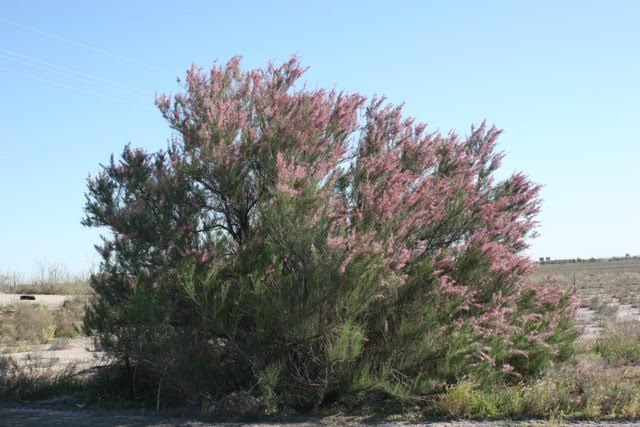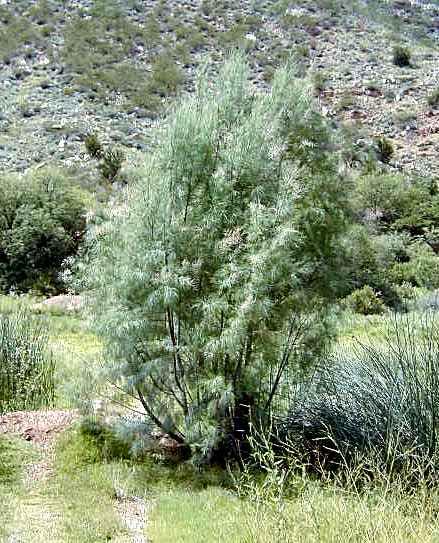What Caused the Spread of Saltcedar and the Decline of Cottonwood Along the Rio Grande?

As this article explains, cottonwood decline was caused by river dams which ended seasonal flooding, not by an “invasion” of saltcedar.
NOTE: article was originally published in the Hudspeth County Herald April 1, 2016
In October 1916, dignitaries gathered at the Rio Grande, near present-day Truth or Consequences, New Mexico, for an event said to be “of world-wide importance in the irrigation field.” It was the dedication of Elephant Butte Dam, then the largest impoundment reservoir in the world.
It would store the river’s spring floodwaters. By regulating flows, it promised to “make the desert bloom” from Southern New Mexico to El Paso and Juarez.
But the dam also triggered a chain of unintended consequences. The riverside habitat was transformed. A century later, scientists are still tracking these sweeping changes. The Chihuahuan Desert is outstanding in many respects. For example, it’s got a lot of sand and soil. There’s not much vegetation to hold soil in place. When rains pour into hills and canyons, side channels move tremendous amounts of sediment into the Rio Grande.
The Rio Grande requires powerful flows to move that sediment down to the Gulf of Dam at Elephant Butte, on Rio Grande, Mexico. When Elephant Butte was dammed up, the annual springtime floods – fueled by snowmelt from the Rocky Mountains – came to an end. And sediment began to accumulate in the river.
Dan Cadol is a professor of hydrology at the New Mexico Institute of Mining and Technology in Socorro.
“But when we block that off, all of that sediment in transport gets trapped in the reservoir and slowly fills it up,” Cadol said. “In the case of the Rio Grande, about a quarter of the reservoir capacity has been filled up by sediment over the last 100 years, since it was closed in 1916.”
Even downstream there was significant impact. Peak flows declined by as much as 75 percent. The river channel filled in. As a result, when storms occur, the river is more likely to flood.
To help hold down soils, land managers introduced a new plant in the 1920s, native to Asia – the tamarisk, or salt cedar. It reduced sediment accumulation in the reservoir. But that wasn’t its only effect.
Before tamarisk, cottonwoods and willows dominated the riverside habitat. And they were adapted to the cycle of spring floods. Not so for tamarisk.
“All summer long it’s just pumping out seeds constantly – whereas the cottonwood only releases seeds to coincide with when the snowmelt ought to be coming downriver,” Cadol said of tamarisk. “So the fact that these floods happen and clear a little bit of land, put down nice silt that’s a great bed for these seeds to grow in, the seedlings that start to grow are the tamarisk seeds, because the floods happen when there are no cottonwood seeds around.”
Tamarisk spread along the Rio Grande. Here’s what happened in the Presidio Valley in Texas.
Cotton farming there expanded after the New Mexico dam was built. But when cotton prices dropped, this farmland was taken out of production. What happened next gave tamarisk a foothold. In 1942, there was a “spillover” at Elephant Butte. The flood washed silt onto the fallow fields. As a result, monocultures of tamarisk grew, from Candelaria to the confluence of the Rio Conchos.
Wildlife has been impacted. Deer and other herbivores once fed on grasses along the river, but thickets of tamarisk edged the grasses out. Meanwhile, other species adapted – like the endangered willow flycatcher, which now makes its nests in tamarisks.
Elephant Butte was a forerunner. In the decades that followed, dams were built on rivers across the West. These dams were usually built for a 50-year lifespan. Now, at 100 years, Elephant Butte has delivered on some of its promises. It’s allowed the United States to meet water obligations to Mexico, and it’s supported irrigated farming.
But it’s also inefficient. Thirty percent of the water that reaches the reservoir is lost to evaporation. With the effects of climate change, snowmelt is expected to occur earlier. And this means evaporation losses will increase. Plus, the reservoir continues to fill with sediment.
Cadol wonders about the future of dams like Elephant Butte.
“It’s definitely a critical question that’s facing the water-management community, especially in the Southwest,” he said. “Hopefully there will be strong leadership that can guide us through that.”
One thing is clear – at a hundred years, Elephant Butte is a reminder that when we change nature, the results are always more complicated than we expect.
Saltcedar: “The Rest of the Story”
Obviously an advanced civilization needs infrastructure including dams, highways and power lines. These will impact the environment. In minimizing harm from the development and changes, we need to distinguish between symptoms and root causes. Saltcedar eradication efforts present a classic example of confusing symptoms and root causes.
To quote David Theodoropolus, author of Invasion Biology: Critique of a Pseudo Science:
Saltcedar (Tamarix spp.) Is said to be a disastrous ecological menace, one of the nation’s worst weeds, changing river hydrology, increasing flooding, sedimentation, and salinization, crowding out cottonwood (Populus deltoides) and willow (Salix spp.), and driving native species ‘…to the edge’ (Malakoff 1999; U.S. Congress Office of Technology Assessment 1993).
Yet, studies have demonstrated that native seedlings are competitively superior to saltcedar (Sher et al. 2000), and that it establishes in soils too saline for natives to germinate (Anderson 1996).
Stromberg (1998) found that saltcedar actually enhances floristic diversity—herbaceous species richness and cover is significantly greater in saltcedar than cottonwood, and stem densities of native woody successional species are equivalent.
Anderson (1998) has found that avian species richness and density in saltcedar is equivalent to native vegetation, and ‘biomass and diversity of insects in saltcedar stands is comparable to those in cottonwood and willow.’
In fact, 90 percent of the endangered willow flycatcher (Empidonax traillii extimus) nest in saltcedar (Malakoff 1999).
Over 35 years ago Everitt (1980) pointed out that saltcedar is only a symptom of abuse of riparian areas, and he has recently stated: ‘There is no evidence that it actively displaced native species nor that it played an active role in changing the hydraulic or morphological properties of the river’ (Everitt 1998).
These are not biased people: all have killed saltcedar during riparian restorations.”

At Circle Ranch we have found saltcedar to be a highly desirable small tree—one of a handful which make it in our desert. Recently, acting on its invasive species ideology, and without consent of affected landowners like ourselves, the feds released an exotic beetle into our deserts. This exotic invasive is now at Circle Ranch where it has killed saltcedar, and in our opinion, other desirable trees and plants. None of the universities, agencies and NGOs, which together comprise Big Wildlife, objected to this action. Along the rivers this action was supposed to have restored, the result has been loss of wildlife diversity, increased erosion, intensified fire hazard and more undesirable weeds. Contrary to predictions by proponents including Texas A&M, water flow hasn’t increased, salinity hasn’t decreased and no cottonwoods have been restored. In summary, saltcedar was a symptom, but never the root cause of cottonwood decline. Obviously, eradicating the last saltcedar will not restore cottonwood to areas where cottonwood can no longer grow.
This wasteful and inappropriate response to the unintended consequences of disrupting nature has led to more unintended consequences and more inappropriate responses. Now poisons are being used to control the beetle accelerating the system’s downward spiral, as Big Wildlife in its arrogant ignorance doubles down on attempts to “save” biodiversity by destroying biodiversity.
While there are no simple restoration answers, there are many, many intelligent choices. Yet everywhere, we see fortunes spent to reintroduce or increase favored species, almost always by killing something else. These generally fail, but like the beetle fiasco are routinely misrepresented to a gullible public as successful, ecologically sound strategies.
Recently I toured a beautiful ranch on the Purgatoire River in Southeastern Colorado, owned by The Nature Conservancy (TNC). As on the Rio Grande, miles and miles of eroding river banks, creeks and canyons have stands of dying saltcedar. The senior TNC officer said the the beetle release was “a great success”! When I asked if beaver would eat saltcedar, he replied that the most beautiful beaver dam he had ever seen was just upstream of the ranch we were on, constructed entirely of saltcedar.
So why, instead of releasing an exotic invasive beetle, didn’t Big Wildlife first try to restore native beaver, once abundant in Colorado’s rivers? Wouldn’t beaver have cleared much saltcedar, created wetlands, and likely recreated conditions more favorable to native trees like cottonwood than to saltcedar? His “instant answer” is that remnant beaver are already present in the few places where they can survive; elsewhere, the water levels have dropped too low for them to live.
As we all know, beavers are water engineers, which is why many consider them invasive pests. Raising water tables is what beavers do!
Wolves and beavers, acting as riverbank restoration engineers in places like Yellowstone National Park, beat poisons, bullets, beetles and “managers” hands down. But for four generations, land grant colleges have indoctrinated ag and wildlife students to believe that invasive species ideology, with its endless lists of proscribed plants and animals, is a science; and that chemical fertilizers and pesticides can replace sustainable agriculture practices. Add a huge public sector to keep busy, and are we surprised that minimalist practices are seldom considered?
Although Big Wildlife’s “silver bullets” of plant poisons and animal eradications increase employment for “managers” and revenues for the chemical giants, they almost always backfire. Saltcedar had many desirable features and unquestionably was better than the dead-zones that replaced it, to say nothing of the invasive beetles.
Let us learn from our mistakes: The intelligent restoration choice is nudging systems back towards natural patterns. Meanwhile, let nature heal herself by recruiting pioneer plants or animals. As and if the system recovers, the native plants, like cottonwood, will again predominate. If not, let us recognize that when we change the environment we change the plants and animals with it—and these changes are often improvements over what would otherwise remain.

